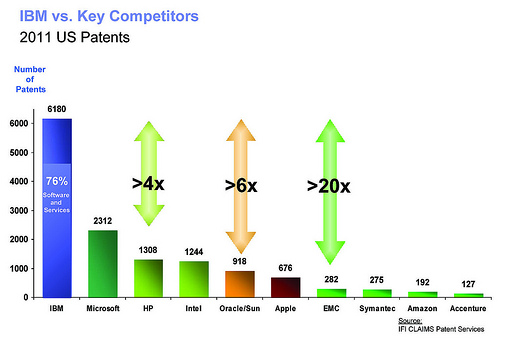Big Blue may be caught in its image as the perennial patents-received leader, for better or worse.
Obtaining large numbers of patents is often more effective for large companies than securing a handful of really good ones.
U.S. patent count leader IBM, which has boldly dominated patents-received for two decades, has made something of an art in the science of securing IP rights. It has obtained 46,000 U.S. patents since 2000, and more than 6,000 in 2011 alone. Of those, it has allowed about two-thirds to lapse.
Until recently, companies like Google and Apple had chosen not to compete in this costly and somewhat cynical numbers game. Winning the patent count race means more to large IT businesses than others. However, the patents a business receives should not be confused with those it holds or is able capitalize on because of the inventions they read on.
Does IBM know something about IP management that other companies do not? Or are cash-rich Google and Apple simply prepared to make bold purchases or settlements when necessary for defensive purposes? Some think that IBM is caught in its own IP image, believing to appear innovative more patents are inevitably better.
When Narcissus fell in love with his reflection in a pool of water, he got soaked. If I recall my Greek Mythology correctly it was Nemesis that attracted Narcissus to the pool in the first place.
* * *
The value of IBM’s volume strategy, which is generally more meaningful to large consumer products companies, such as smart phone makers, may be less readily cost-justified than it once was. Many companies like H-P and AT&T are filing about the same number of patents or even fewer than in the past, concentrating on balancing patent counts, quality and current needs.
In the January IAM magazine (number 57), which will be published next week, the Intangible Investor is devoted to IBM’s out-sized lead in obtaining patents. (They allow most to lapse within about 24 months, suggesting that for some holders it is as important to keep patents out of the hands of the wrong parties as it is to maintain them.) Emphasizing their patent-securing prowess has until now has worked for Big Blue, an IP licensing powerhouse that is seldom sued for infringement.
With its business model now focused on services, and the public smarter about IP rights, IBM is not in need of more patents, but better ones. Of course it depends on how they intend to use them and on how they choose to measure performance.
In “The need to lead: IBM under the microscope,” out next week in IAM, Brody Berman Associates compiled “aggregate totals” for US patents granted to leading IT companies from 2000 to 2011. Over this period IBM (46,292) was granted, 2.5 to four times as many patents as Microsoft (18,120), HP (17,699) and Intel (17,484).”
* * *
IBM is unabashedly proud of its out-sized dominance in patent counts, besting some innovative competitors by 20-fold. (See the graphic from IFI Claims, above.)
Is Big Blue’s volume approach — which it shares with Intellectual Ventures and several defensive-mined Japanese companies like NEC, Hitachi, Sony and Canon — a relic of patent wars past?
Patent portfolios are a means to support innovation and and facilitate performance, not an end to qualify them.
Illustration sources: Brody Berman Associates; IBM Annual Report




Very interesting statistics and good questions about whether the volume approach still makes sense in today’s world. Of course, the business of and markets of the patent owner are important considerations in determining how large a portfolio to seek.
LikeLike